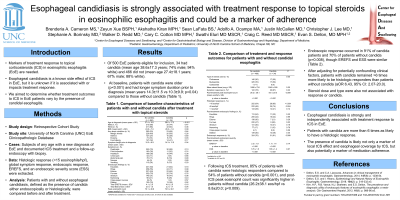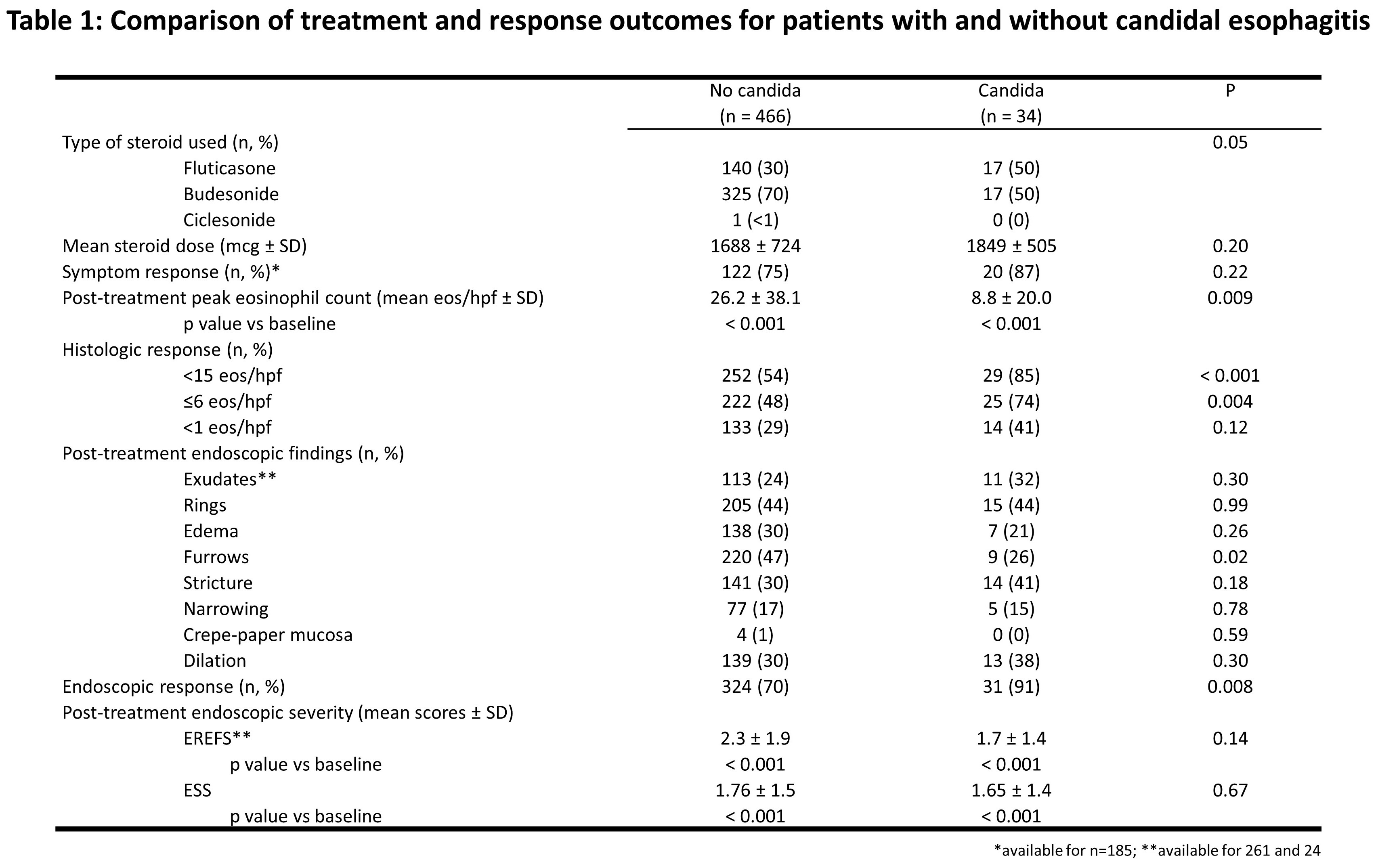Sunday Poster Session
Category: Esophagus
P0397 - Esophageal Candidiasis Is Strongly Associated With Treatment Response to Topical Steroids in Eosinophilic Esophagitis and Could Be a Marker of Adherence
Sunday, October 22, 2023
3:30 PM - 7:00 PM PT
Location: Exhibit Hall

Has Audio

Brenderia A. Cameron, MS
University of North Carolina School of Medicine
Chapel Hill, NC
Presenting Author(s)
Brenderia A.. Cameron, MS, Angela Xue, BSPH, Akshatha Kiran, MPH, Sean LaFata, BS, Adolfo A.. Ocampo, MA, Justin McCallen, MD, Christopher J.. Lee, MD, Stephanie A.. Borinsky, MD, Walker D.. Redd, MD, Cary C.. Cotton, MD, MPH, Swathi Eluri, MD, MSCR, Craig C.. Reed, MD, MSCR, Evan S. Dellon, MD, MPH
University of North Carolina School of Medicine, Chapel Hill, NC
Introduction: Markers of treatment response to topical corticosteroids (tCS) in eosinophilic esophagitis (EoE) are needed. Esophageal candidiasis is a known side effect of tCS in EoE, but it is unknown if it is associated with or impacts treatment response. We aimed to determine whether treatment outcomes to tCS in EoE patients vary by the presence of candidal esophagitis.
Methods: We conducted a retrospective cohort study of the UNC EoE Clinicopathologic database. Subjects were patients of any age with a new diagnosis of EoE per consensus guidelines, who also had documented treatment with a tCS and a follow-up endoscopy with biopsy. Histological response was defined as < 15 eos/hpf, with additional assessment of ≤6 and < 1 eos/hpf. Global symptomatic response, endoscopic response, EREFS, and endoscopic severity score (ESS) were also obtained. Patients with and without esophageal candidiasis, defined as the presence of candida either endoscopically or histologically, were compared before and after treatment
Results: Of 500 EoE patients eligible for inclusion, 34 had candida (mean age 38.6±17.3 years; 74% male; 94% white) and 466 did not (mean age 27.4±18.1 years; 67% male; 88% white). At baseline, patients with candida were older (p< 0.001) and had longer symptom duration prior to diagnosis (mean years 14.3±11.5 vs 10.3±9.9; p=0.04) compared to those without candida. Following tCS treatment, 85% of patients with candida were histologic responders compared to 54% of patients without candida (p< 0.001), and post-tCS peak eosinophil count was significantly higher in patients without candida (26.2±38.1 eos/hpf vs 8.8±20.0; p< 0.009). Endoscopic response occurred in 91% of candida patients and 70% of patients without candida (p=0.008), though EREFS and ESS were similar (Table). Symptom response was similar regardless of candida. After adjusting for potentially confounding clinical factors, patients with candida remained >6 times more likely to be histologic responders than patients without candida (aOR 6.43, 95% CI: 2.07-20.0). Steroid dose and type were also not associated with response or candida
Discussion: Esophageal candidiasis is strongly and independently associated with treatment response to tCS in EoE. Patients with candida are more than 6 times as likely to have a histologic response. The presence of candida is likely not only a marker of local tCS effect and esophageal coverage by tCS, but also potentially a marker of medication adherence

Disclosures:
Brenderia A.. Cameron, MS, Angela Xue, BSPH, Akshatha Kiran, MPH, Sean LaFata, BS, Adolfo A.. Ocampo, MA, Justin McCallen, MD, Christopher J.. Lee, MD, Stephanie A.. Borinsky, MD, Walker D.. Redd, MD, Cary C.. Cotton, MD, MPH, Swathi Eluri, MD, MSCR, Craig C.. Reed, MD, MSCR, Evan S. Dellon, MD, MPH. P0397 - Esophageal Candidiasis Is Strongly Associated With Treatment Response to Topical Steroids in Eosinophilic Esophagitis and Could Be a Marker of Adherence, ACG 2023 Annual Scientific Meeting Abstracts. Vancouver, BC, Canada: American College of Gastroenterology.
University of North Carolina School of Medicine, Chapel Hill, NC
Introduction: Markers of treatment response to topical corticosteroids (tCS) in eosinophilic esophagitis (EoE) are needed. Esophageal candidiasis is a known side effect of tCS in EoE, but it is unknown if it is associated with or impacts treatment response. We aimed to determine whether treatment outcomes to tCS in EoE patients vary by the presence of candidal esophagitis.
Methods: We conducted a retrospective cohort study of the UNC EoE Clinicopathologic database. Subjects were patients of any age with a new diagnosis of EoE per consensus guidelines, who also had documented treatment with a tCS and a follow-up endoscopy with biopsy. Histological response was defined as < 15 eos/hpf, with additional assessment of ≤6 and < 1 eos/hpf. Global symptomatic response, endoscopic response, EREFS, and endoscopic severity score (ESS) were also obtained. Patients with and without esophageal candidiasis, defined as the presence of candida either endoscopically or histologically, were compared before and after treatment
Results: Of 500 EoE patients eligible for inclusion, 34 had candida (mean age 38.6±17.3 years; 74% male; 94% white) and 466 did not (mean age 27.4±18.1 years; 67% male; 88% white). At baseline, patients with candida were older (p< 0.001) and had longer symptom duration prior to diagnosis (mean years 14.3±11.5 vs 10.3±9.9; p=0.04) compared to those without candida. Following tCS treatment, 85% of patients with candida were histologic responders compared to 54% of patients without candida (p< 0.001), and post-tCS peak eosinophil count was significantly higher in patients without candida (26.2±38.1 eos/hpf vs 8.8±20.0; p< 0.009). Endoscopic response occurred in 91% of candida patients and 70% of patients without candida (p=0.008), though EREFS and ESS were similar (Table). Symptom response was similar regardless of candida. After adjusting for potentially confounding clinical factors, patients with candida remained >6 times more likely to be histologic responders than patients without candida (aOR 6.43, 95% CI: 2.07-20.0). Steroid dose and type were also not associated with response or candida
Discussion: Esophageal candidiasis is strongly and independently associated with treatment response to tCS in EoE. Patients with candida are more than 6 times as likely to have a histologic response. The presence of candida is likely not only a marker of local tCS effect and esophageal coverage by tCS, but also potentially a marker of medication adherence

Figure: Table 1
Disclosures:
Brenderia Cameron indicated no relevant financial relationships.
Angela Xue indicated no relevant financial relationships.
Akshatha Kiran indicated no relevant financial relationships.
Sean LaFata indicated no relevant financial relationships.
Adolfo Ocampo indicated no relevant financial relationships.
Justin McCallen indicated no relevant financial relationships.
Christopher Lee indicated no relevant financial relationships.
Stephanie Borinsky indicated no relevant financial relationships.
Walker Redd indicated no relevant financial relationships.
Cary Cotton indicated no relevant financial relationships.
Swathi Eluri indicated no relevant financial relationships.
Craig Reed indicated no relevant financial relationships.
Evan Dellon: Abbott – Consultant. Abbvie – Consultant. Adare/Ellodi – Consultant, Grant/Research Support. Aimmune – Consultant. Akesobio – Consultant. Alfasigma – Consultant. ALK – Consultant. Allakos – Consultant, Grant/Research Support. Amgen – Consultant. Aqilion – Consultant. Arena/Pfizer – Consultant, Grant/Research Support. Aslan – Consultant. AstraZeneca – Consultant, Grant/Research Support. Avir – Consultant. Banner Pharmaceuticals – Grant/Research Support. Biorasi – Consultant. Calypso – Consultant. Celgene/Receptos/BMS – Consultant, Grant/Research Support. Celldex – Consultant. Eli Lilly – Consultant. EsoCap – Consultant. Eupraxia – Consultant. Ferring – Consultant. Gossamer Bio – Consultant. GSK – Consultant, Grant/Research Support. Holoclara – Consultant, Grant/Research Support. Invea – Consultant, Grant/Research Support. Knightpoint – Consultant. Landos – Consultant. LucidDx – Consultant. Meritage – Grant/Research Support. Miraca – Grant/Research Support. Morphic – Consultant. Nexstone Immunology – Consultant. Nutricia – Consultant, Grant/Research Support. Parexel/Calyx – Consultant. Phathom – Consultant. Regeneron Pharmaceuticals Inc. – Consultant, Grant/Research Support. Revolo Biotherapeutics – Consultant, Grant/Research Support. Robarts/Alimentiv – Consultant. Salix – Consultant. Sanofi – Consultant. Shire/Takeda – Consultant, Grant/Research Support. Target RWE – Consultant. Upstream Bio – Consultant.
Brenderia A.. Cameron, MS, Angela Xue, BSPH, Akshatha Kiran, MPH, Sean LaFata, BS, Adolfo A.. Ocampo, MA, Justin McCallen, MD, Christopher J.. Lee, MD, Stephanie A.. Borinsky, MD, Walker D.. Redd, MD, Cary C.. Cotton, MD, MPH, Swathi Eluri, MD, MSCR, Craig C.. Reed, MD, MSCR, Evan S. Dellon, MD, MPH. P0397 - Esophageal Candidiasis Is Strongly Associated With Treatment Response to Topical Steroids in Eosinophilic Esophagitis and Could Be a Marker of Adherence, ACG 2023 Annual Scientific Meeting Abstracts. Vancouver, BC, Canada: American College of Gastroenterology.
